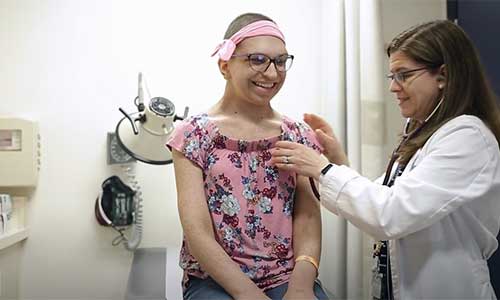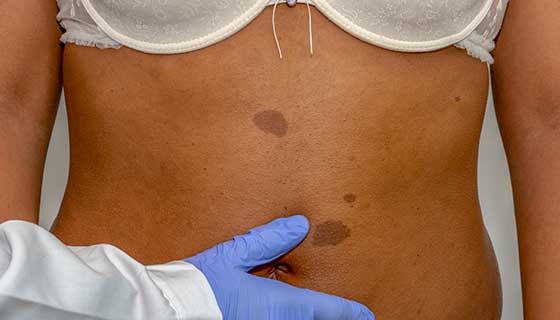Neurofibromatosis
What You Need to Know
- Neurofibromatosis (NF) is a term that describes three genetic diseases caused by mutations in genes that lead to increased risk of developing tumors.
- Different types of neurofibromatosis lead to growth of different tumors (neurofibromas and schwannomas) in various parts of the body.
- Doctors diagnose NF based on the patient’s family history, imaging studies, certain signs and symptoms, and sometimes genetic testing.
- Treatments are available to manage neurofibromatosis symptoms, but a cure is not available.
What is neurofibromatosis?
Neurofibromatosis is a genetic disorder that causes tumors to form throughout the body. It is progressive and is one of the most common genetic diseases in the United States. Although neurofibromatosis is not a cancer, some forms of NF can be associated with certain malignancies. Neurofibromas and schwannomas are two common tumor types that can result from neurofibromatosis.
Types and Symptoms of Neurofibromatosis
Neurofibromatosis encompasses three distinct disorders: neurofibromatosis type 1 (NF1), neurofibromatosis type 2 (NF2) and schwannomatosis. Each type is characterized by tumors along the peripheral nerves, and symptoms that are different for each disorder.
- Neurofibromas, most often seen in patients with NF1, appear as multiple, rubbery lumps on or under the skin. They may be painful or itchy, but many do not cause any other symptoms.
- Vestibular schwannomas are most common in patients with NF2. These tumors affect the nerves of the inner ear and disrupt hearing and balance.
- Schwannomatosis is associated with painful tumors called schwannomas that can cause pain, tingling and weakness.
Other signs of NF include:
- Lisch nodules, which are tiny bumps that appear on the iris (the colored part of the eye). They are common in people with NF1, and an ophthalmologist might spot them during an eye exam.
- Clusters of freckles under the arms, or in skin folds and creases
- Six or more cafe-au-lait spots, which are tan or brown patches on the skin
NF1 Versus NF2
Both NF1 and NF2 are genetic conditions that affect nerve tissue, but NF1 and NF2 have different symptoms. NF1, far more common than NF2, is characterized by brownish cafe-au-lait spots on the skin and tumors called neurofibromas. NF1 can also cause deformity of bones and has several other manifestations. The abnormal nerve growths of NF2 more frequently affect the nerves inside the skull and spine, and common symptoms include problems regarding hearing, balance and control of facial muscles.
Neurofibromatosis in Children
Signs of neurofibromatosis type 1 may be present soon after birth, and some signs, such as cafe au lait spots, can be present at birth. Neurofibromas most often appear in children between the age 10 to 15.
The signs and symptoms of NF2 and schwannomatosis are rare in children and usually appear in people in their 20s or 30s.
Parents of children with NF should consult a specialist and help monitor their children for headaches, painful tumors, bone changes affecting their legs or spine, and issues regarding development and puberty. Some neurofibromas can become cancerous.
Neurofibromatosis is not curable, but most children who have it live full, normal lives.
Neurofibromatosis Diagnosis
Neurofibromatosis disorders are often diagnosed by a doctor’s examination of the patient and genetic testing.
After a careful history and examination, the doctor may order several tests including the following.
- MRI
- Electromyography (EMG)/nerve conduction study (NCS), to measure electrical pathways in the nerves.
- A biopsy, so that a pathologist can diagnose a neurofibroma or schwannoma by looking at a piece of the tumor under a microscope
Neurofibromatosis Treatment
Mild cases of NF1, NF2 and schwannomatosis do not cause severe problems, and affected people may require no treatment beyond observation and regular checkups and symptom management. Children born with neurofibromatosis should be monitored by their doctor, who can help detect complications such as hearing problems, bone deformities and changes to skin lesions.
Tumors and bone changes caused by neurofibromatosis can be treated with surgical and nonsurgical methods. Care should be coordinated by a genetics expert, and may involve neurologists, orthopaedic surgeons and other specialists.
Currently, there is no approved medication to treat neurofibromatosis, but researchers are exploring potential therapies, including MEK inhibitors — drugs that block a protein associated with abnormal cell growth.
Surgery for Neurofibromatosis
If a schwannoma or neurofibroma causes significant pain or loss of neurological function, compresses a nearby structure or shows rapid growth on imaging, the doctor may recommend removing it surgically and/or by using radiation.
Depending on the tumor’s location and size, and its involvement with the nerve, removal can be challenging and require the skill of an experienced surgeon who specializes in nerve tumors. A team approach is recommended, with neurosurgeons working together with plastic and reconstructive surgeons and other experts. Scarring will likely occur, and recurrence of the tumor is possible.

NF Care at Johns Hopkins
The Johns Hopkins Comprehensive Neurofibromatosis Center is one of the few specialized centers in the world helping patients with NF1, NF2 and schwannomatosis. Our multi-specialty team uses the latest treatment approaches that aim to address all aspects of living with NF.
Neurofibromatosis and Cancer
NF is not a form of cancer. Neurofibromas are tumors (abnormal growths), but are usually benign (not likely to spread to other places in the body).
However, cancerous changes can occur in certain types of neurofibromas, especially a plexiform neurofibroma that can turn into a sarcoma (a soft tissue tumor). A rare type of sarcoma is a malignant peripheral nerve sheath tumor (MPNST), which is very serious and can be life threatening.
People with NF1, especially children, have a higher than average risk of developing a glioma — a nervous system tumor. Gliomas are most likely to appear in a child with NF who is 4 and 5 years old. In most cases, these tumors are low grade and manageable.





